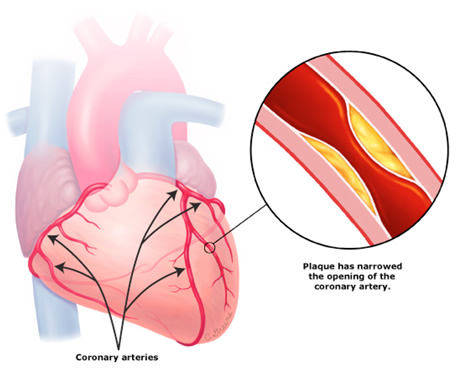Coronary Heart Disease
Our mission is to improve the health and well-being of our Bay Area residents through integrated and compassionate patient care, education and research.
Welcome new doctors
Upgraded new patient portages
Redesigned website
Coronary Heart Disease
Coronary Heart Disease
What is coronary heart disease?
Coronary heart disease is a condition that puts you at risk for heart attack and other forms of heart disease. In people who have coronary heart disease, the arteries that supply blood to the heart get clogged with fatty deposits (figure below). Other names for this disease are “coronary artery disease” or just “heart disease.”

What are the symptoms of coronary heart disease?
Most people with coronary heart disease have no symptoms. In fact, the first symptom of the disease can be a heart attack. That’s why it is so important to know how to spot a heart attack.
The symptoms of a heart attack can include:
- Pain, pressure, or discomfort in the center of the chest
- Pain, tingling, or discomfort in other parts of the upper body, including the arms, back, neck, jaw, or stomach
- Shortness of breath
- Nausea, vomiting, burping, or heartburn
- Sweating or having cold, clammy skin
- A racing or uneven heartbeat
- Feeling dizzy or lightheaded
If these symptoms last more than 10 minutes or they keep coming and going, call 9-1-1 for an ambulance right away. Do not try to get to the hospital on your own.
Some people with coronary heart disease have chest pain even when they are not having a heart attack. This is most likely to happen when they are walking, going up stairs, or moving around. But if you have chest pain that is new or different than pain you have had before, you should see a doctor right away.
Is there a test for coronary heart disease?
Yes. If your doctor or nurse thinks you might have coronary heart disease, he or she might order blood tests and one or more of these tests:
- An electrocardiogram (“ECG” or “EKG”) – This test measures the electrical activity in your heart.
- A stress test – During a stress test, you might be asked to run or walk on a treadmill while you also have an ECG. Physical activity increases the heart’s need for blood. This test helps doctors see if the heart is getting enough blood. If you cannot walk or run, your doctor might do this test by giving you a medicine to make your heart pump faster.
- An echocardiogram – This test uses sound waves to create an image of your heart as it beats.
- Cardiac catheterization – Cardiac (heart) catheterization is also known as cardiac “cath” or coronary angiography. During this test the doctor inserts a thin tube into a blood vessel in your leg or arm and threads it up to your heart. Then the doctor injects a dye that shows up on an x-ray. This dye can show whether any of the arteries in your heart are clogged.
How is coronary heart disease treated?
The main treatments for coronary heart disease are:
- Lifestyle changes – You can reduce your risk of heart attack and death by:
- Quitting smoking, if you smoke.
- Eating lots of fruits and vegetables and low-fat dairy products, but not a lot of meat or fatty foods.
- Walking or doing some form of physically activity on most days of the week.
- Losing weight, if you are overweight.
- Medicines – The medicines to treat heart disease are very important. Some medicines lower your risk of heart attacks and can help you live longer. But you must take them every day, as directed. Medicines your doctor might prescribe include:
- Medicines called statins, which lower cholesterol
- Medicines to lower blood pressure
- Aspirin or other medicines that help prevent blood clots
People who have chest pain caused by coronary heart disease (called “angina”) can also get medicines to relive their pain. These medicines might include “nitrates,” “beta blockers,” and others.
Some people with coronary heart disease can also have:
- Angioplasty (also known as “stenting”) – During angioplasty, a doctor puts a thin tube into a blood vessel in the leg or arm and threads it up to the heart. Then the doctor inflates a tiny balloon inside the clogged artery to reopen it. Often the doctor props open the artery using a tiny mesh tube called a stent.
- Bypass surgery (also known as “coronary artery bypass grafting”) – During bypass surgery, the doctor removes a piece of blood vessel from another part of the body. Then he or she reattaches the blood vessel above and below the area that is clogged. This re-routes blood around the clog, and allows it to get to the part of the heart that was not getting blood.
